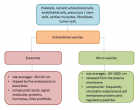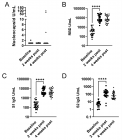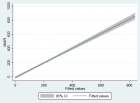Abstract
Research Article
Effect of Pre-Treatments and Drying Methods on the Chemical Quality and Microbial Density of Wild Edible Oyster Mushroom
Ibrahim TA*, Adaramola-Ajibola KM, Adesuyi AT, Olanrewaju SO and Akinro EB
Published: 31 August, 2017 | Volume 1 - Issue 1 | Pages: 039-044
This study was carried out to evaluate the effect of pretreatments and drying methods on the chemical quality and microbial density of wild edible oyster mushroom. The mushroom samples were pretreated by steeping in 0.5% citric and sodium metabisulphite at room temperature for 10 minutes before being subjected to sun and cabinet drying until a constant weight was reached. The dried samples including the control samples (Samples not pretreated with chemicals) were evaluated for proximate, mineral composition and microbial density. The proximate analysis (protein, ash, fat, moisture and fibre) showed that untreated mushroom samples (both sun and cabinet dried) had the overall best results followed by samples pretreated with 0.5% sodium metabisulphite while samples pretreated with 0.5% citric acid had the lowest values. The mineral analysis (calcium, sodium, magnesium and potassium) of the mushroom samples followed the same trend as the proximate analysis. The microbial density of the samples showed that samples pretreated with 0.5% citric acid had the lowest count followed by samples pretreated with 0.5% sodium metabisulphite while the untreated samples had the highest microbial density. This implies that pretreatment with citric acid and sodium metabisulphite reduced the microbial density which may invariably extend the storage life of the edible oyster mushroom.
Read Full Article HTML DOI: 10.29328/journal.afns.1001007 Cite this Article Read Full Article PDF
Keywords:
Pretreatments; Mushroom; Solutions; Quality; Drying; Edible; Wild
References
- Walde SG, Velu V, Jyothirmayi T, Math RG. Effects of pretreatments and drying methods on dehydration of mushroom. Journal of Food Engineering. 2006; 74: 108-115. Ref.: https://goo.gl/RfLwP9
- Chang ST, Buswell JA. Mushroom nutraceuticals. World J Microbial Biotechnical. 1996; 12: 473-476. Ref.: https://goo.gl/QaeiZq
- Yapar S, Helvaci SS, Peker S. Drying behavior of mushroom slices. Drying Technology. 1990; 8: 77-79. Ref.: https://goo.gl/HFEp8M
- Kelshrewtha M, Singh A, Vipal D. Effect of drying conditions on mushrooms quality. Journal of engineering science and technology. 2009; 4: 96-98.
- Kalač P. A review of chemical composition and nutritional value of wild-growing and cultivated mushrooms. J Sci Food Agric. 2013; 93: 209-218. Ref.: https://goo.gl/R85tw3
- Alam SM. Importance of mushrooms. NIA, Tando Jam, Pakistan, (2008).
- Lidhoo CK, Agrawal YC. Hot-air over drying characteristics of button mushroom-safe drying temperature. Mush Res. 2006; 15: 59-62.
- Argyropoulos D, Heindl A, Müller J. Evaluation of processing parameters for hot-air drying to obtain high quality dried mushrooms in the Mediterranean region. Conference on International Research on Food Security, Natural Resource Management and Rural Development, Tropentag. 2008; 7-9. Ref.: https://goo.gl/j7mwNa
- Suguna S, Usha M, Narayanan VV, Raghupathy R, Gothandapani L. Dehydration of mushroom by sun drying, thin layer drying, fluidized bed drying and solar cabinet drying. J Fd Sci Technol. 1995; 34: 284-288.
- Alan B, Arleen BR, Fischer DW. Mushrooms of Northeastern North America. Hong Kong: Library of Congress Cataloging-in-Publication Data. 1997.
- Arora S, Shivhare US Ahmed J, Raghavan GSV. Drying kinetic of Agarius bisporuns and pleurotus florida mushroom. American society of Agriciltural Engineers. 2003; 46: 721-724. Ref.: https://goo.gl/R9kY2o
- Official methods of analysis. Association of official analytical chemists. Washington D.C., USA. 2005
- Chang S, Miles PG. Mushrooms, Cultivation, Nutritional Value, Medicinal Effect, and Environmental Impact, CRC Press, America. 2004.
- Rama V, John PJ. Effects of methods of drying and pretreatments on quality of dehydrated mushroom. Indian Food Packer. 2000; 54: 59-64.
- World Health Organization Technical series. Trace elements in human nutrition and health. World Health Organization, Geneva. 2005; 199-205.
- Mattila P, Könkö K, Eurola M, Pihlava JM, Astola J. Contents of vitamins, mineral elements, and some phenolic compounds in cultivated mushrooms. J Agric Food Chem. 2001; 49: 2343-2348. Ref.: https://goo.gl/e1XYMa
- Czapski J. Evaluation of chemical composition of commercially canned mushrooms processed from fresh and desalted mushrooms and derived from different geographic regions. Veg Crops Res Bull. 2003; 58: 135-141.
- Komanowooky M, Talley FB, Eskew RK. Air drying of culyivated mushrooms. Food Technology. 1997; 32: 1020-1024.
- Aishah MS, Wan Rosli WI. Effect of different drying techniques on the nutritional values of oyster mushroom pleurotus sajor-caju. Saina Malaysian. 2013; 42; 937-941.
- Singh U, Jain SK, Doshiz A, Jain HK, Chahar VK. Effects of pretreatments on drying characteristics of button mushroom. International Journal of Food Engineering. 2008; 4.
- International Commission on Microbiology for Specification for Food. Microorganisms in Food: Their Significance and Methods of Enumeration. 2nd Edn., University of Toronto Press, Toronto, Canada. 1978.
Figures:
Similar Articles
-
Effect of storage period on the quality characteristics of two varieties of African Mango Seed Flour at ambient temperatureAdedeji TO*. Effect of storage period on the quality characteristics of two varieties of African Mango Seed Flour at ambient temperature. . 2017 doi: 10.29328/journal.afns.1001002; 1: 012-019
-
Effect of pre-treatments and drying methods on Moisture percentage of dried Tomato SlicesPokharkar KK*,Delvadia DV,Jadhav Parag B,Bhor PB. Effect of pre-treatments and drying methods on Moisture percentage of dried Tomato Slices. . 2017 doi: 10.29328/journal.afns.1001004; 1: 024-026
-
Effect of drying methods on the physicochemical properties and Fatty Acid composition of Moringa Seeds OilIbrahim TA*,Oloye DA,Omosuli SV. Effect of drying methods on the physicochemical properties and Fatty Acid composition of Moringa Seeds Oil . . 2017 doi: 10.29328/journal.afns.1001005; 1: 027-032
-
Effect of Pre-Treatments and Drying Methods on the Chemical Quality and Microbial Density of Wild Edible Oyster MushroomIbrahim TA*,Adaramola-Ajibola KM,Adesuyi AT,Olanrewaju SO,Akinro EB. Effect of Pre-Treatments and Drying Methods on the Chemical Quality and Microbial Density of Wild Edible Oyster Mushroom. . 2017 doi: 10.29328/journal.afns.1001007; 1: 039-044
-
Development and quality evaluation of Jam from Watermelon (Citrullus Lanatus) and Pawpaw (Carica Papaya) juiceAdedeji Temileye Omotayo*. Development and quality evaluation of Jam from Watermelon (Citrullus Lanatus) and Pawpaw (Carica Papaya) juice. . 2017 doi: 10.29328/journal.afns.1001010; 1: 063-071
-
Nutritional and structural evaluation of selected Black gram varieties for preparation of Fermented Thick Pancake (Dosa)Kavitha B*,Sugasini D*,Poorna CR Yalagala,Hemalatha C,Kanchana S,Meenakshi V,Umamaheswari R. Nutritional and structural evaluation of selected Black gram varieties for preparation of Fermented Thick Pancake (Dosa). . 2018 doi: 10.29328/journal.afns.1001011; 2: 001-009
-
A case report: Electrochemical impedance spectroscopy as an Al-ternative for cell counting chambers of yeast (Saccharomyces cerevisiae) for brewery applicationsGeorg Christoph Brunauer*,Alina Meindl,Bernhard Rotter,Alfred Gruber,Christoph Slouka. A case report: Electrochemical impedance spectroscopy as an Al-ternative for cell counting chambers of yeast (Saccharomyces cerevisiae) for brewery applications. . 2021 doi: 10.29328/journal.afns.1001029; 5: 027-031
-
Agaricus brasiliensis (Sun mushroom) and its therapeutic potential: A reviewAline Mayrink de Miranda*. Agaricus brasiliensis (Sun mushroom) and its therapeutic potential: A review. . 2022 doi: 10.29328/journal.afns.1001032; 6: 006-015
-
Pretreatments, dehydration methods and packaging materials: effects on the nutritional quality of tomato powder: a reviewLamesgen Yegrem*,Lejalem Abeble Dagnaw. Pretreatments, dehydration methods and packaging materials: effects on the nutritional quality of tomato powder: a review. . 2022 doi: 10.29328/journal.afns.1001038; 6: 050-061
-
Beneficial effects of a ketogenic diet in a woman with Charcot-Marie-Tooth diseaseElvira Rostanzo,Anna Maria Aloisi*. Beneficial effects of a ketogenic diet in a woman with Charcot-Marie-Tooth disease. . 2022 doi: 10.29328/journal.afns.1001040; 6: 068-072
Recently Viewed
-
The efficacy of complex Decongestive Physiotherapy in patients with Bilateral Primary Lower Extremity Lymphedema and Untreatable multiple health conditions: A Case ReportHümeyra Kiloatar PT*. The efficacy of complex Decongestive Physiotherapy in patients with Bilateral Primary Lower Extremity Lymphedema and Untreatable multiple health conditions: A Case Report. J Nov Physiother Rehabil. 2017: doi: 10.29328/journal.jnpr.1001011; 1: 093-098
-
Cystoid Macular Oedema Secondary to Bimatoprost in a Patient with Primary Open Angle GlaucomaKonstantinos Kyratzoglou*,Katie Morton. Cystoid Macular Oedema Secondary to Bimatoprost in a Patient with Primary Open Angle Glaucoma. Int J Clin Exp Ophthalmol. 2025: doi: 10.29328/journal.ijceo.1001059; 9: 001-003
-
Metastatic Brain Melanoma: A Rare Case with Review of LiteratureNeha Singh,Gaurav Raj,Akshay Kumar,Deepak Kumar Singh,Shivansh Dixit,Kaustubh Gupta*. Metastatic Brain Melanoma: A Rare Case with Review of Literature. J Radiol Oncol. 2025: doi: ; 9: 050-053
-
Depression as a civilization-deformed adaptation and defence mechanismBohdan Wasilewski*,Olha Yourtsenyuk,Eugene Egan. Depression as a civilization-deformed adaptation and defence mechanism. Insights Depress Anxiety. 2020: doi: 10.29328/journal.ida.1001013; 4: 008-011
-
Drinking-water Quality Assessment in Selective Schools from the Mount LebanonWalaa Diab, Mona Farhat, Marwa Rammal, Chaden Moussa Haidar*, Ali Yaacoub, Alaa Hamzeh. Drinking-water Quality Assessment in Selective Schools from the Mount Lebanon. Ann Civil Environ Eng. 2024: doi: 10.29328/journal.acee.1001061; 8: 018-024
Most Viewed
-
Evaluation of Biostimulants Based on Recovered Protein Hydrolysates from Animal By-products as Plant Growth EnhancersH Pérez-Aguilar*, M Lacruz-Asaro, F Arán-Ais. Evaluation of Biostimulants Based on Recovered Protein Hydrolysates from Animal By-products as Plant Growth Enhancers. J Plant Sci Phytopathol. 2023 doi: 10.29328/journal.jpsp.1001104; 7: 042-047
-
Sinonasal Myxoma Extending into the Orbit in a 4-Year Old: A Case PresentationJulian A Purrinos*, Ramzi Younis. Sinonasal Myxoma Extending into the Orbit in a 4-Year Old: A Case Presentation. Arch Case Rep. 2024 doi: 10.29328/journal.acr.1001099; 8: 075-077
-
Feasibility study of magnetic sensing for detecting single-neuron action potentialsDenis Tonini,Kai Wu,Renata Saha,Jian-Ping Wang*. Feasibility study of magnetic sensing for detecting single-neuron action potentials. Ann Biomed Sci Eng. 2022 doi: 10.29328/journal.abse.1001018; 6: 019-029
-
Pediatric Dysgerminoma: Unveiling a Rare Ovarian TumorFaten Limaiem*, Khalil Saffar, Ahmed Halouani. Pediatric Dysgerminoma: Unveiling a Rare Ovarian Tumor. Arch Case Rep. 2024 doi: 10.29328/journal.acr.1001087; 8: 010-013
-
Physical activity can change the physiological and psychological circumstances during COVID-19 pandemic: A narrative reviewKhashayar Maroufi*. Physical activity can change the physiological and psychological circumstances during COVID-19 pandemic: A narrative review. J Sports Med Ther. 2021 doi: 10.29328/journal.jsmt.1001051; 6: 001-007

HSPI: We're glad you're here. Please click "create a new Query" if you are a new visitor to our website and need further information from us.
If you are already a member of our network and need to keep track of any developments regarding a question you have already submitted, click "take me to my Query."


















































































































































